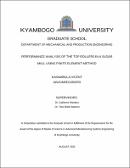| dc.description.abstract | Sugar milling is the process of extracting juice from crushed sugarcane fibres for production of
sugar crystals. The three-shaft sugar mill set consists of the top roller and two bottom rollers to
crush the sugarcane. The top roller shaft is the main crushing shaft of the sugar mill which is directly
attached to the prime mover so it rotates and is loaded. Therefore, the top roller shaft in the mill set
is subjected to more torsion and bending stresses. This study examined the mechanical performance
of four top rollers under dynamic loading in four mill sets 1-4 of the sugar plant. To achieve this,
firstly, the forces on the top rollers were determined and stresses on the top rollers were analysed
using the maximum shear stress method to determine the unsafe loaded zones of the top rollers.
Secondly, camera photos were obtained for visual inspection, detailed micrographs of the failed
surfaces were obtained for microstructural examination; and the chemical composition and
hardness of the failed components were determined and compared with known material standards
for the top roller bare shafts, roller shells and couplings. Thirdly, geometrical models of the top
roller were generated using solid works and transferred to ANSYS workbench which was used to
analyse the maximum displacement, fatigue sensitivity, safety factor and equivalent alternating
stress for the subjected dynamic loading in sugar milling; monotonic and cyclic parameters of
forged steel were used for the bare shaft and parameters of ductile cast iron were used for the roller
shell. The results of the shear stress analysis, microstructural characterization, and chemical
composition and hardness of the failed top rollers showed that material non-conformance
contributed to shaft failures. Maximum displacement, fatigue sensitivity and equivalent alternating
stress showed that failure occurs at shoulders, key-way and shaft square ends; and top rollers in mill
sets 3 and 4 are more susceptible to failure than top rollers in mill sets 1 and 2. The study evaluated
the fatigue performance of top rollers in sugar mills.
Keywords: Top Roller Shafts, Dynamic loading, Shear Stress, Alternating Stress, Mechanical
Performance. | en_US |

